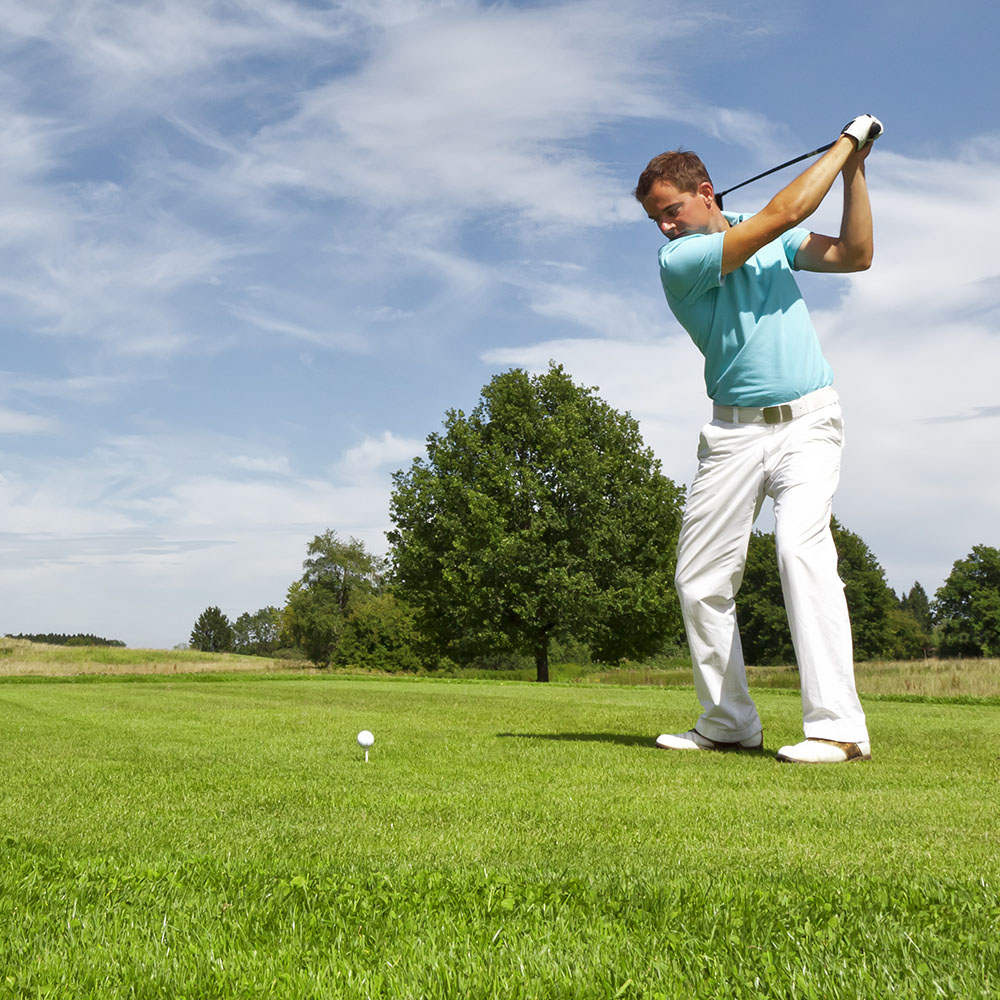
What is Sportsvision
Around 1993 American PGA pro Jim Hartnett started noticing inconsistencies in the swings of PGA West and tour players and realized eye dominance was the critical component.
Ten years later Sportvision optometrist Richard Hughes in beautiful Galway Ireland was also trying to convey the importance of eye dominance in golf. Jim and Richard had never met. In 2017 Jim published “Golf for the other 80%” which focuses on eye dominance. Three years later Richard read Jim’s book and realized that vision theory and Jim’s coaching experience were in complete harmony and that nobody else knew or understood this.
Theory may now be able to explain why the majority of tour players are cross dominant, left eye dominant and right handed or vice versa and why there are so few with a dominant right eye who are right handed.
The cone of vision
Golf is a highly visual sport. Vision is by far the most important sense, from which most sporting skills emanate. It is therefore the first place to look for problems.
The way the eye sees the world could be considered a cone of vision. At the centre of the cone is the fovea the most sensitive part of the vision on the retina. As vision spreads out from the centre (the peripheral vision), it becomes less sensitive to detail but far more sensitive to movement and shape. When the eye is static the brain will take information from every part of the cone (visual field) central and peripheral. In the drive for instance the centre of the cone will be focused on the back surface of the ball, while the outer part of the cone will be tracking the path of the down swing as the image of the club traverses peripheral retina.
Timing the shot and confidence in the final acceleration to impact are dependent on the movement and direction of the hands, shaft and club, seen peripherally. This is a highly refined skill in elite players. The importance of the outer parts of the cone could be illustrated by attempting to drive off the tee in blinkers.
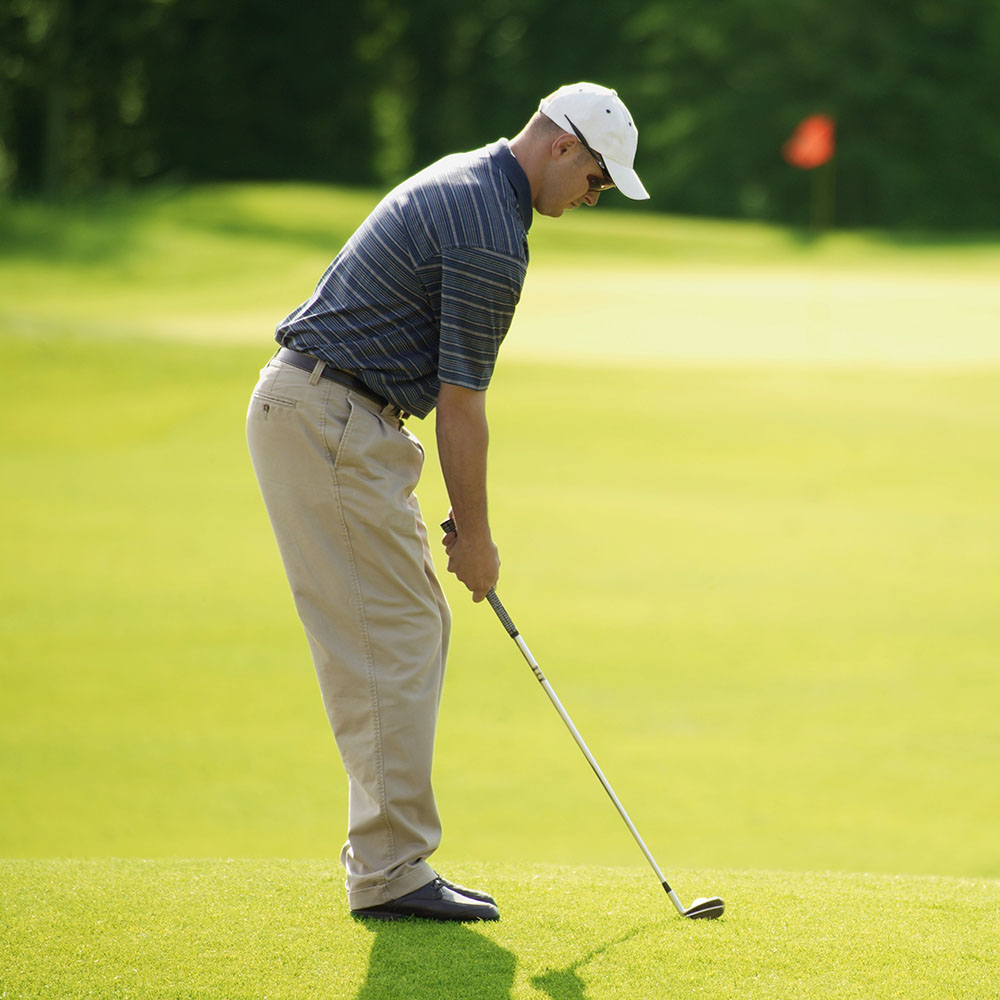
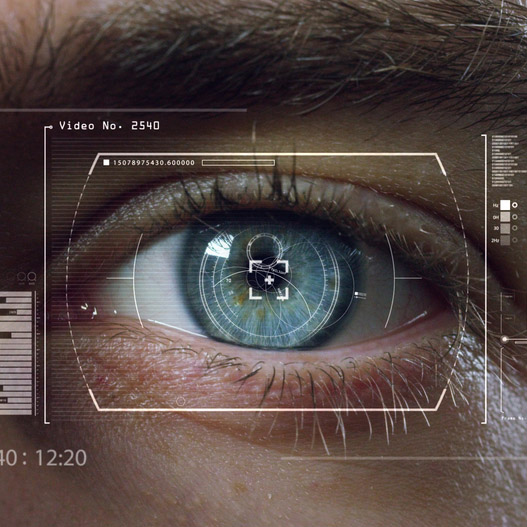
Bi foveal fixation
The visual process in one eye is already complex but now this complexity is significantly increased by the way the eyes work together. Understanding how the two eyes work together (binocular vision) and the importance of bi-foveal fixation (the centres of each cone working together) is critical to the accuracy and repeatability of perhaps the most important shot in the game of golf – the drive
Eye dominance
Eye dominance is an innate characteristic. It is the platform on which all other visually dependent skills are built. The dominant or aiming eye determines our position relative to the object we are looking at. Once the position of the object is established the non-dominant eye is then used to judge its distance. The distance between the eyes means the image of the object will be slightly displaced from the centre of the fovea in the non-dominant eye. The brain is able to relate this separation to the distance of the object.
Type I and Type II dominance
Most people have a clearly dominant eye not least because of the evolutionary advantages of being able to judge position and depth in a forward facing hunter-gatherer. For scientific convenience it is possible to divide the population into two dominance Types:
• Type I: right eye, right hand and foot dominant
• Type II: any left tendency in eye, hand or foot
The way in which people develop and perceive the world is profoundly affected by their dominance Type. This is reflected in sport where some are better suited to Type I, and others to Type II. The plethora of sporting choices may be a reflection the diversity of visual skills more than anything else, which starts with the demarcation of the two dominance Types.
Up to 80% of Tour players are cross dominant Type II (right handed and left eye dominant or vice versa) compared with the general population where there appears to be a much higher incidence of Type I. It is surprising that in a sport of comparable visual difficulty like Clay Target shooting where aiming is the critical skill, right dominant eye shooters seem to have the advantage2. Clay shooters also keep both eyes open, the question is why are there so few Type I tour players in golf.
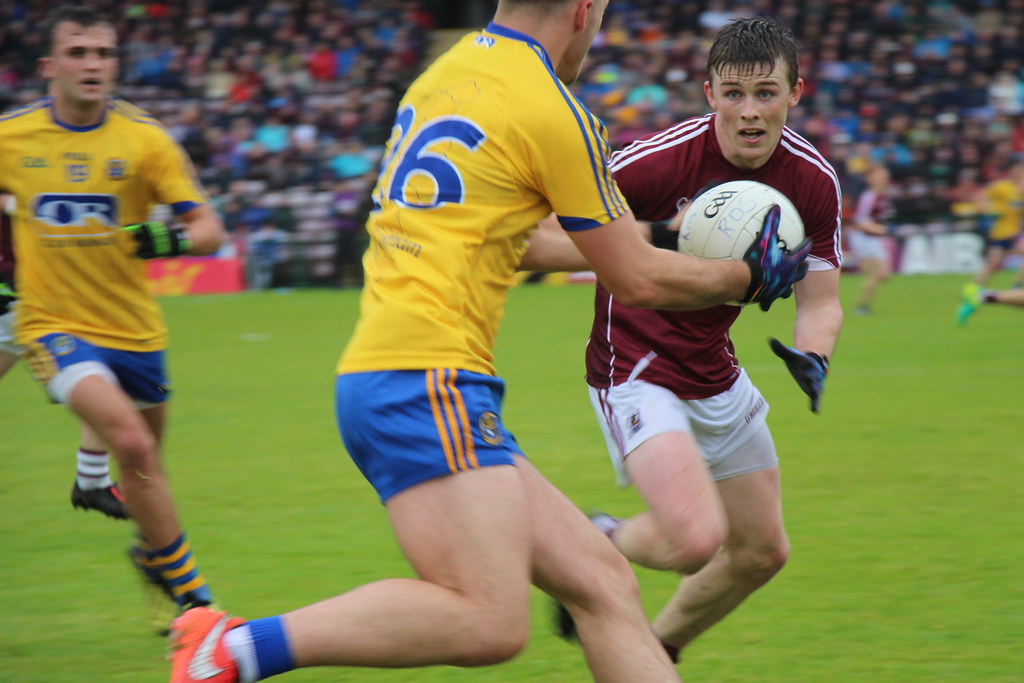
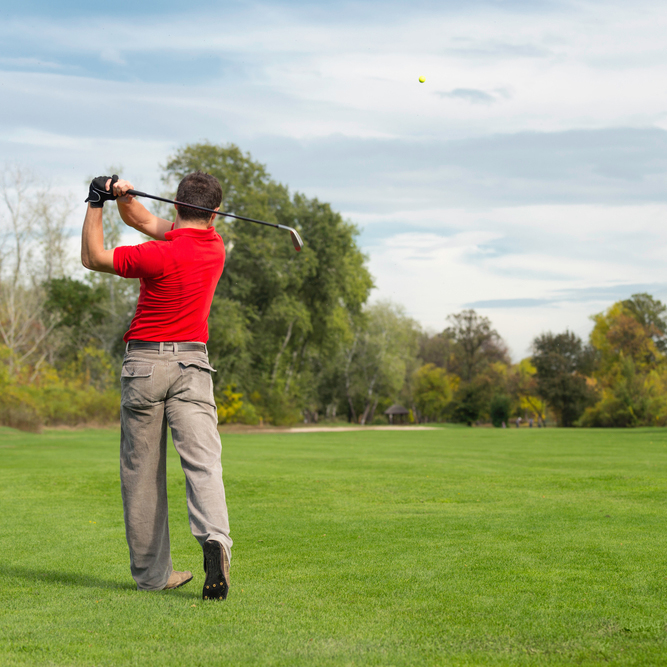
The Backswing
A fundamental principle of Newton’s Law of motion is that the harder a ball is hit the further it will go. It follows that a coaching imperative will be to maximise the backswing when driving off the tee in golf. For a fixed accelerating force (the power of the golfer), the longer the back swing, the greater the speed at the point of impact.
The role of aiming in Golf
A characteristic of aiming sports is that visual attention should never waver5. Vision leads the execution of the shot and any deviation of aim during the process of the drive will be magnified at the end of the flight; a five-degree misalignment of the clubface at impact results in a 25m miss at 300 metres.
The aiming skill in Type I players Bi foveal fixation will ensure accurate depth perception and ball position (Right eye, hand and dimple on the back surface of the ball all in line). As the club is drawn back a judgement of the distance and position of the ball is maintained throughout the swing. As the backswing continues the head should remain steady to allow the right eye (ball position) and the left eye (distance of the ball) to maintain bi-foveal fixation. If the back swing is extended too far it will force the shoulders out of line and the head to follow. If the head turns far enough the nose will obscure the vision of the ball in the right eye, when this happens the left non-dominant eye will take over the aiming task. In that instant without the player realising, the apparent position of the ball will change.
Ocular Dominance and apparent ball position
There are two ways to demonstrate this effect and the underlying importance of ocular dominance:
1. Hold the hands as if they were holding the club and extend the index finger of the right (lower) hand to aim it at the ball with the right eye open. Then close the right eye and open the left eye and see that the ball appears to move to the left (See Fig 1).
If this happens at the top of the swing because the nose obscures the right eye the same thing will happen to the position of the ball. The brain now sees the ball to the left of where it actually is in relation to the hands that would be guiding the club.
2. Holding the club with the lower right hand index finger extended so that the dominant right eye, index finger, shaft and ball /club interface are all in line with the left eye shut (See Fig 2). This time when the left eye is opened and the right eye shut the club and the ball will not appear to move. The extended index finger on the right hand however will now be pointing to a patch of grass to the right of the ball and club (See Fig 3). You may also observe an apparent movement of the shaft to the left. This shows the clubface and ball have moved because the index finger is now pointing to where they were originally.
The reason that the ball and club do not appear to move is that they are both in the same position relative to each another, so the brain assumes nothing has moved.
Because there has been no apparent movement of the ball and clubface the only way to know that something has changed is the movement of the pointing index finger. This is not easy to see because the eyes ignore the detail of what they are not looking at directly due to a doubling effect that we learn to suppress. This phenomenon is called physiological or normal diplopia (double vision) See Fig 4.
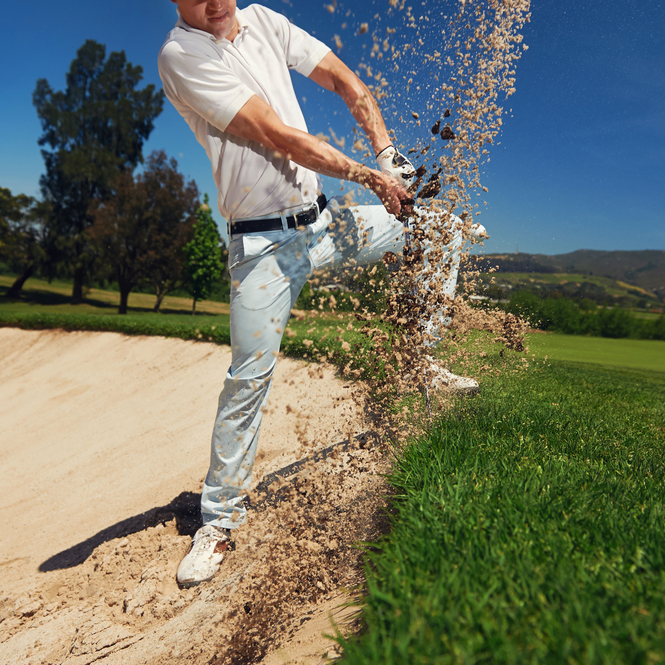
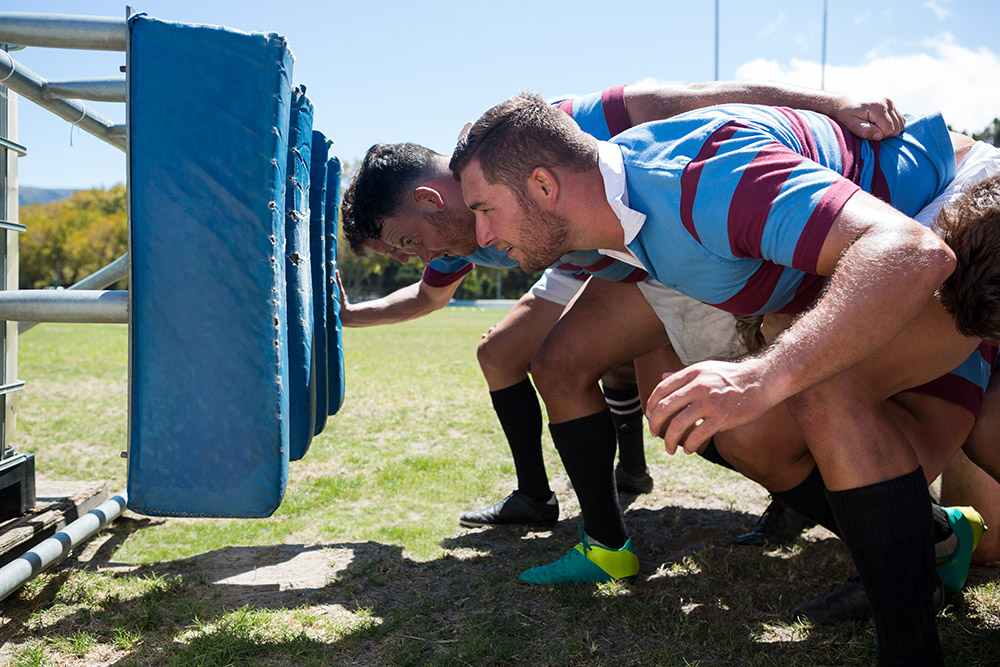
Physiological Diplopia
This phenomenon may be why experienced golfers are sceptical that anything changes (as they address the ball to begin the swing) when they close their dominant eye. Physiological diplopia can be demonstrated by looking at a golf ball on the floor and holding up pencil 12 inches from the nose; as concentration is maintained on the ball two pencils will suddenly appear on either side of it (See Fig 4).
When the ball is addressed and attention is on the clubface the detail of what is happening to the hands will be ignored. Extending the index finger of the right hand breaks this illusion because when the left eye is opened and the right eye shut, the finger is pointing to the right of the ball and club
When there is a long-standing binocular imbalance the visual system compensates by extending its ability to suppress even when both eyes are trying to look at the ball, to prevent unwanted double vision.
This extra layer of binocular difficulty would be a big barrier to sporting success in such a visually dependent sport like golf and is unlikely to occur in tour players
Both methods (Fig 1 and Figs 2 and 3) demonstrate the effect of the change of fixation but No 1 is probably the easier way to understand what happens at the top of the swing when the club does not confuse the perception of movement. But equally it is important that golfers can see and understand this effect when holding the club and addressing the ball (Fig 2 and 3).
Eye dominance can have an effect on every aspect and every shot in the game even visualization of the flight of the ball and reading the green, particularly under pressure.
Ocular Dominance and apparent ball position
There are two ways to demonstrate this effect and the underlying importance of ocular dominance:
1. Hold the hands as if they were holding the club and extend the index finger of the right (lower) hand to aim it at the ball with the right eye open. Then close the right eye and open the left eye and see that the ball appears to move to the left (See Fig 1).
If this happens at the top of the swing because the nose obscures the right eye the same thing will happen to the position of the ball. The brain now sees the ball to the left of where it actually is in relation to the hands that would be guiding the club.
2. Holding the club with the lower right hand index finger extended so that the dominant right eye, index finger, shaft and ball /club interface are all in line with the left eye shut (See Fig 2). This time when the left eye is opened and the right eye shut the club and the ball will not appear to move. The extended index finger on the right hand however will now be pointing to a patch of grass to the right of the ball and club (See Fig 3). You may also observe an apparent movement of the shaft to the left. This shows the clubface and ball have moved because the index finger is now pointing to where they were originally.
The reason that the ball and club do not appear to move is that they are both in the same position relative to each another, so the brain assumes nothing has moved.
Because there has been no apparent movement of the ball and clubface the only way to know that something has changed is the movement of the pointing index finger. This is not easy to see because the eyes ignore the detail of what they are not looking at directly due to a doubling effect that we learn to suppress. This phenomenon is called physiological or normal diplopia (double vision) See Fig 4.
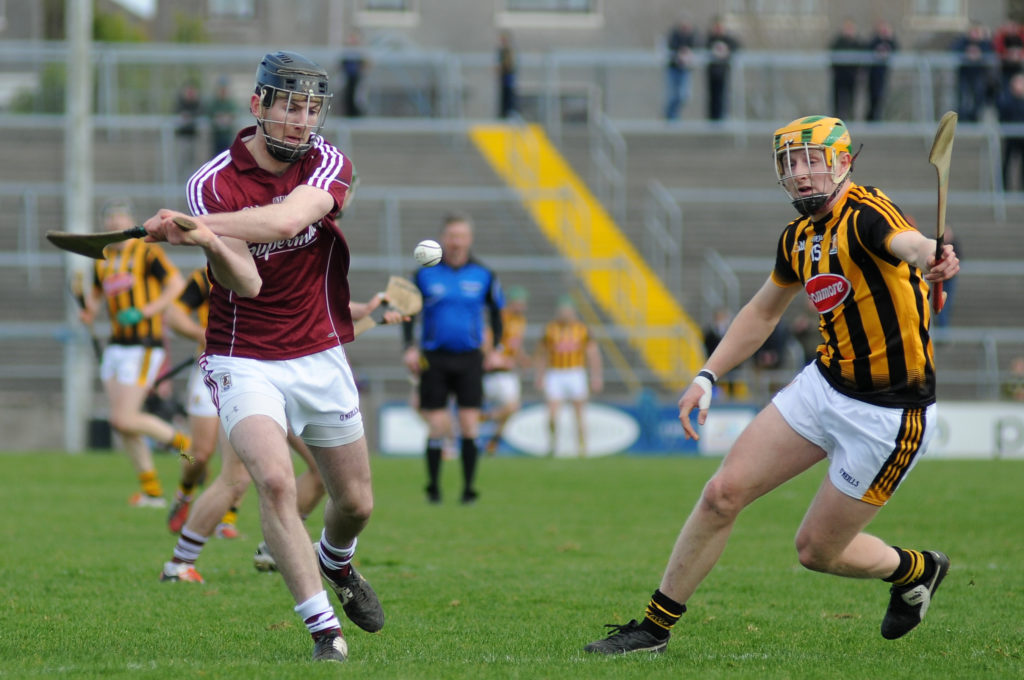
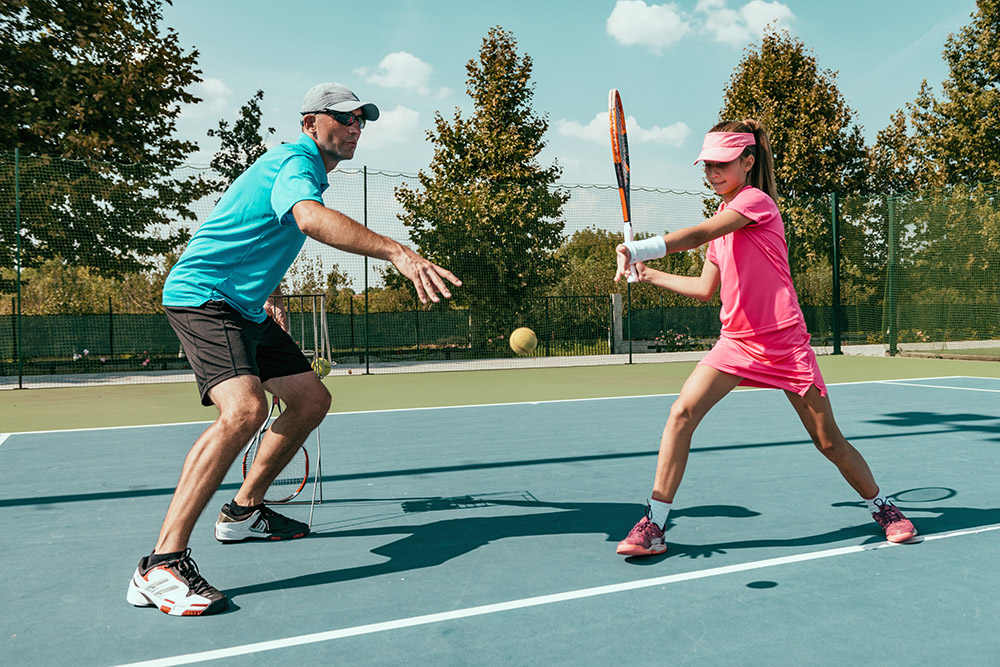
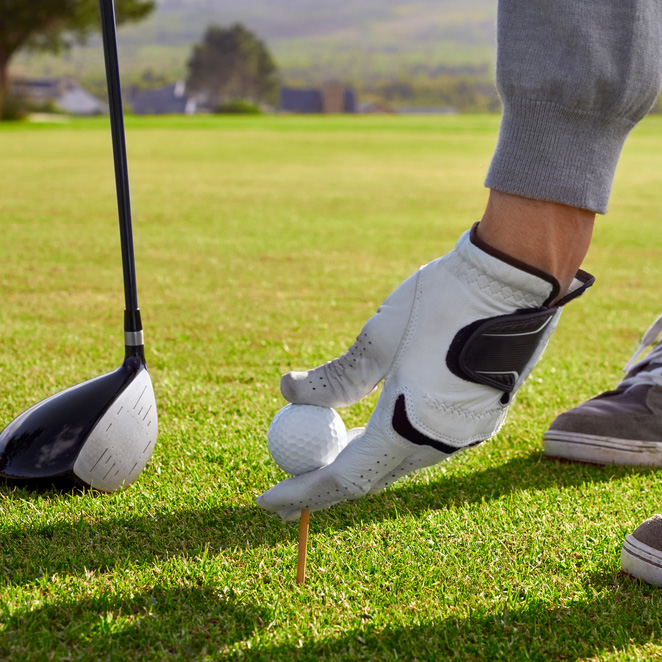
The importance of aiming
It can be seen from Fig 1 that an essential characteristic of true aiming is that the aiming eye (Right in Type I) looks directly at the ball, eye position is fixed and stable. The vision in the left eye is offset to the left. This allows the left eye to calibrate depth by fine changes of focusing and eye position. This microscopic variation in fixation in the non-dominant eye could explain a difference in the anatomy of the fovea of the non-dominant eye in binocularly stable subjects.
The fovea in these subjects is oval in shape (as opposed to circular in the dominant eye) implying an extended range of maximum sensitivity (an ability to search for optimum vision). It may be that far from being subservient to the dominant eye, which could be considered the workhorse of the visual system (the platform on which our perception of the world is based), it is the sensitivity of the non-dominant eye, which creates a picture of depth and subtlety separating the elite from the ordinary.
Once the optimum focus is established the displacement of the image in the left eye compared to the right eye gives the final judgement of depth. Without binocular (bi-foveal) vision depth cannot be judged accurately
The effect of non-dominant aiming (Type I)
When the left eye is forced to take over the aiming task, the ball will appear to move to the left because the left eye is not in line with the shaft and clubface.
This is why too much effort maximising the backswing can cause difficulties for Type I. Excessive shoulder movement can force the head to turn away from the ball so the nose obscures the right eye. The player won’t be particularly aware of this because they’ll still see the ball with the left eye but now its position has apparently changed.
When this happens at the top of the swing, the aim will be reprogrammed to what appears to be the new position of the ball. This means when the clubface comes down to strike the ball it will arrive earlier than expected; the clubface will be open and coming down on the ball.
For the average golfer this will result in a sliced shot with side and topspin, causing the flight of the ball to veer off to the right with reduced elevation. With top level or tour players it could have the opposite effect causing hooks and push shots due to over-compensating for the misleading ball position. This is not a technical fault but what happens when the brain has to guess the position and distance of the ball on the tee.
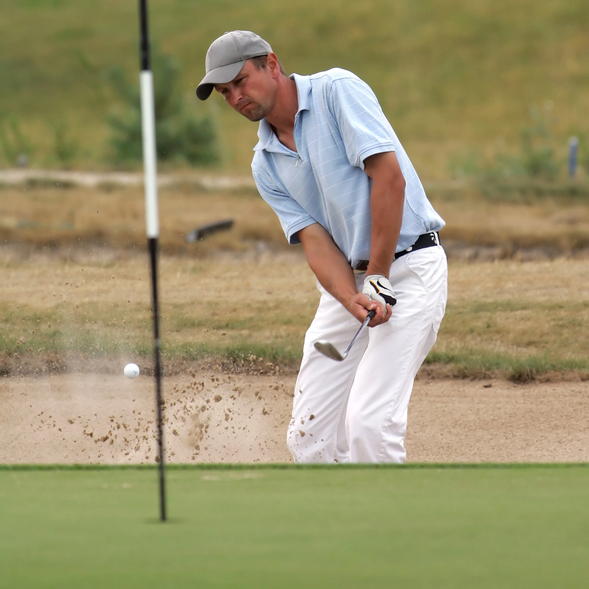
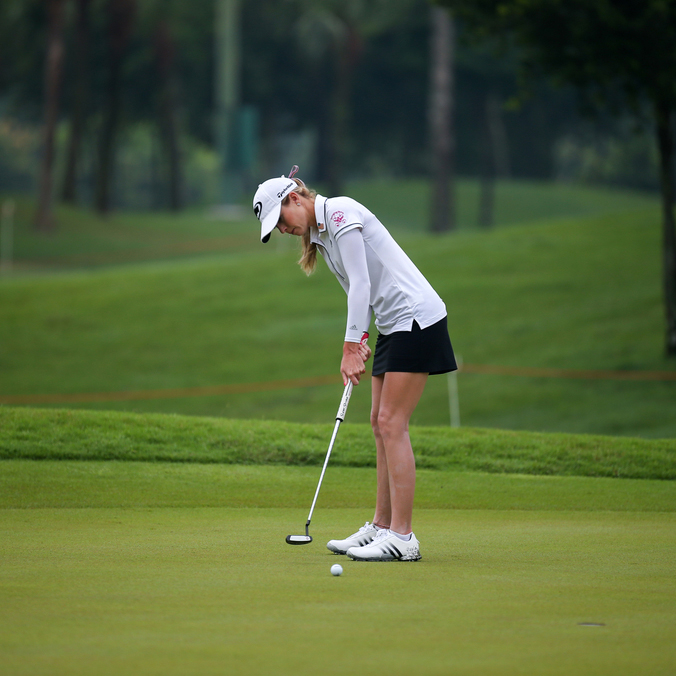
Limitations of swing
Limitations of swing Understanding the limitations of the swing in Type I may explain why the majority of the top golfers are Type II. In Type II the left eye will always have a clear view of the ball, no matter how far back the swing goes. This means that clubface can potentially achieve a higher velocity at the point of impact.
It is not the limitations on back swing that causes the problems with Type I; it is the interruption of binocular vision that happens when trying to emulate the swing of a Type II player. Despite being in the minority there are still great Type I players on the tour. These players can be recognised by the characteristic of a shorter backswing. They are likely to compensate for the reduced swing by an increased the rate of acceleration into the ball (See Figs 5 Mark Hensby showing right eye cone alignment and Fig 6 Gregory Field proper head motion). Contrast this with too much head turn causing loss of dominant eye vision (See Fig 7) Type II does not have it all their own way The Type II player also has residual difficulties to cope with. To achieve the maximum swing they may be forced to turn their head, which means their nose could obscure their non-dominant right eye. When this happens they will lose depth perception making it more difficult to judge the distance of the ball at the end of the club.
In addition the aiming eye and clubface are not perfectly in alignment (see Fig 3) where the aiming eye is now on a different side to which the club is held in a right-handed player). This means in Type II the ball appears consistently further to the left than it does to right eye dominant players who are right handed.
For the Type II player this positional inaccuracy is constant so apart from the danger of loss of bi- foveal fixation (depth perception) at the top of the swing, the player can adapt the position of their clubface or stance by experience. This does add to the complexity of the drive and makes it potentially less reliable as it does in any aiming sport when the sight picture cannot be relied on.
If the Type I player is able to limit the extent of the swing and maintain bi foveal fixation, what they lack in distance could be more than compensated for by accuracy and consistency. It is possible that greater confidence would allow more strength and acceleration to be built into the shorter swing
Visual Correction
And finally it is also important to make sure that there is no other optical and correctable reason for instability of loss of focus, which will have a similar destabilising effect on aim and depth judgement, for instance:
• A muscle imbalance (weak muscle), horizontal or vertical
• A difficulty focusing in dominant eye
• Prescription worse in dominant eye
• All of which applies to the non-dominant eye because of its additional sensitivity and role in depth perception
Ideally the player would have his or her coach working in partnership with a Sportvision specialist to make sure there is no visual impediment to the ability to compete. Players have an intuitive understanding of the importance of vision so the Optometrist can be a powerful ally to the coach in supporting their training and coaching methods.
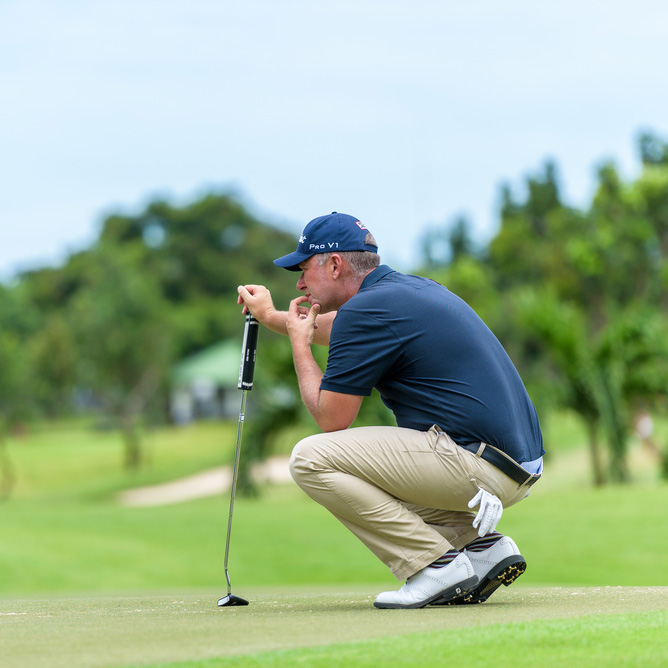
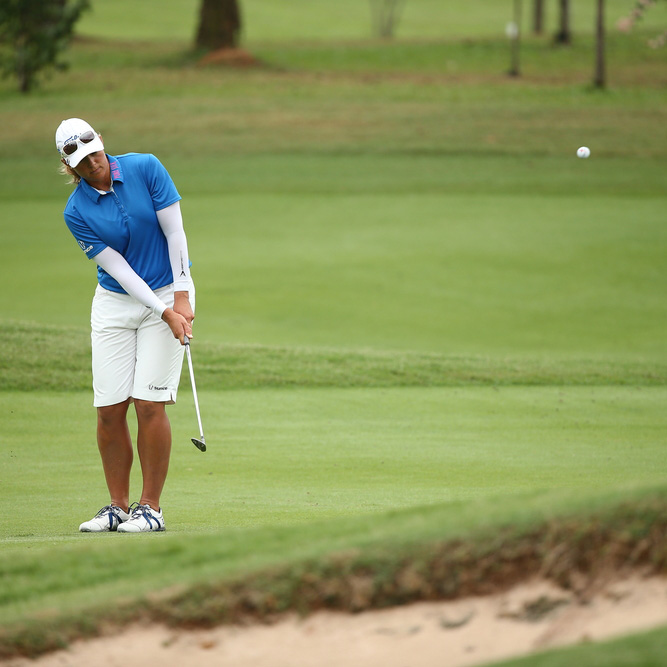
Conclusion
The coming together of optical principles and coaching experience could be transformative for the game of Golf. The understanding of what happens if there is a change of visual perception in the brain during the swing is key. In the context of the golf swing the resultant motor anomalies (the way all the muscles of the body work together) due to the loss of ball position and depth perception has never been fully understood. It can lead to endless hours practicing which simply reinforces the fault and leaves a swing, which is little more than a best guess. Golf is one of the most visually demanding sports and understanding the importance of eye dominance could answer the frustrations of many players including perhaps the majority of Club players.
Authors
Authors Richard Hughes, Dip Sport Vision, Dip School Vision, FASvP FAOI Works in general Optometric practice for 35 years and for the past 15 years has concentrated on sports and school vision. Past examiner for PQE prior to registration in TU Dublin, Holder of the ASvP award for outstanding contribution to School and Sportvision Practice, Has presented at conferences on sports; Hurling, Golf and Children with binocular vision problems. Contact richughes59@gmail.com 00353872518465
Geraint Griffiths BSc Mech Eng, MSc. Optometry MASvP MCOptom MD and founder of Sportvision UK, Chair The Association of Sport and Schoolvision Practitioners (ASvP), Team leader and organiser of 23 international and national sport vision screenings, 40 publications in optical and sports journals. Author of the Diplomas in Sport and Schoolvision, Over 40 years in general practice and 27 years interested and researching Sportvision. Former examiner for the College of Optometrists specialising in binocular vision, Sportvision expert to the British Standards Institute, Former British International High jumper, Welsh and British Masters record holder Contact Geraint@sportvision.co.uk +44 1162363113
Jim Hartnett has been a US PGA Professional for more than 25 years. He worked with all levels of players including many tour players from around the world. He worked at several top facilities including PGA West, Kapalua, and Sahalee Country Club and also worked for Jim McLean. He published two books most recently “Golf for the other 80%” and is working with two doctors to finish the third book, Anatomy of the golf swing. Contact: jimh@pga.com 01-760-289-2879
John Jamieson,
Assistant Professional – Cataraqui Golf and Country Club, Kingston, Ontario, Canada
Member of the PGA of Canada – September 2020
Langara College Golf Team – 2018, 2019;
PacWest Conference All-Star (2019), Langara College Male Athlete of the Year (2019)
Email: jjamieson@cataraqui.com
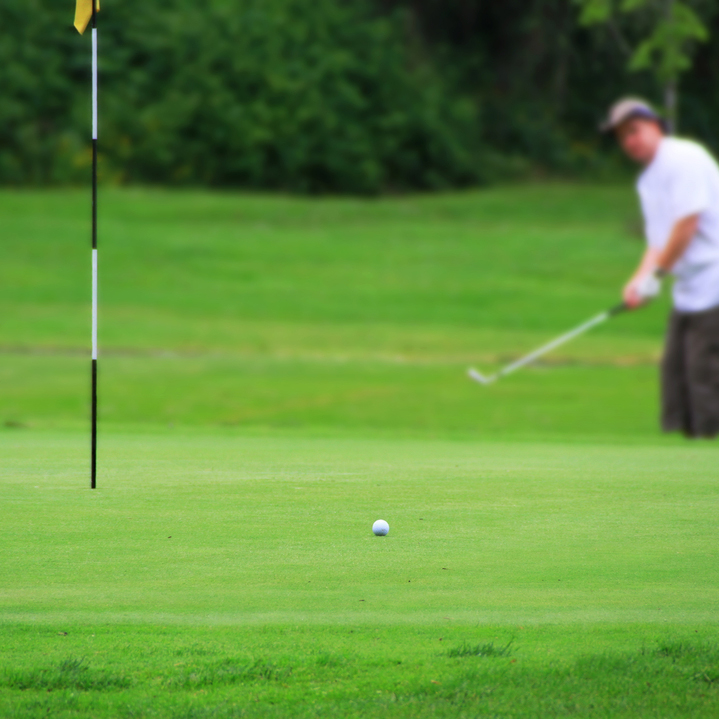
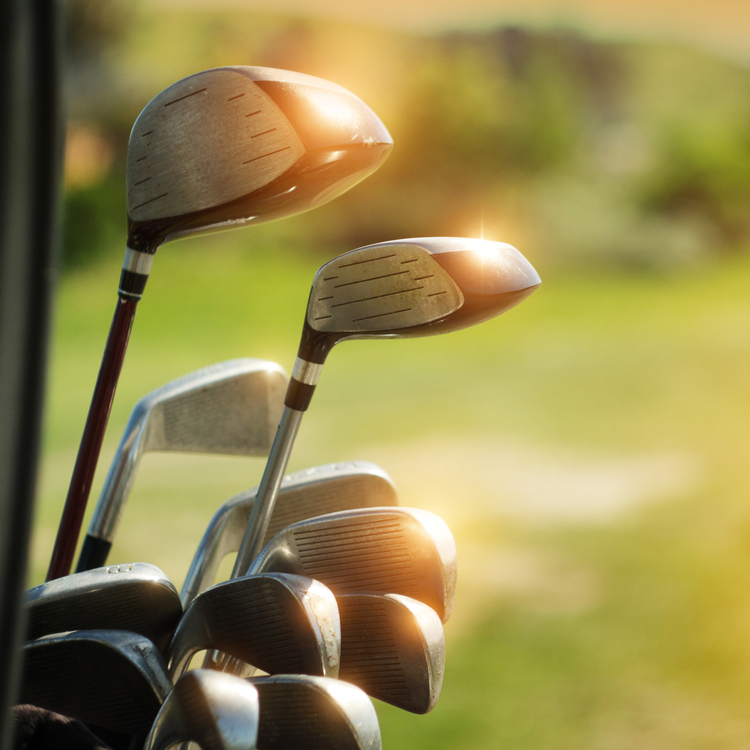
References
1 Griffiths GW et al 2012 Performance and Sport Eye Wear published Optometry Today April 2012
2 Griffiths GW Eye 2003 Eye Dominance in sport – a comparative study Optometry Today Vol 43:16 15.8
3 Griffiths GW 2013 Match finding the best lenses of sport – the science. Dispensing Optics April 2013
4 Harnett J 2017 Golf for the other 80% by Jim Hartnett Pub Independent available: https://www.amazon.com/dp/B06Y5KMT9W/ref=dp-kindle redirect?_encoding=UTF8&btkr=1
5 Griffiths GW 2009 Sport Vision – Visual performance in shooting. Official Journal of the National Small Bore Rifle Association (NSRA) Summer 2009 No 774
6 Albert Le Floch, Guy Ropars 2017 Left–right asymmetry of the Maxwell spot centroids in adults without and with dyslexia The Royal Society Publishing 18 October 2017.DOI:10.1098/rspb.2017.1380
Wrong from the Start – why our approach towards Putting has to start with our Eyes!
Introduction


The Three Keys to Successful Putting
The fundamental objective in putting is getting the ball into the hole – putting is about our ability to
match the path (line) the ball will travel with the correct speed (distance control).
Most professionals will agree that there are three boxes that need to be ticked if we are to improve our
putting – 1) we need to properly identify the break (whether the putt moves left, right, up or down) 2)
we need to start the putt on the line that we’ve identified (can we aim and control the face properly)
and 3) we need to roll the ball with the correct speed. We use our eyes to estimate the break, our brain
to make the calculations from our eyes and feet and our muscles to execute the stroke.
In a study done years ago it is estimated that only about 13% of tour players can aim at the center of
the hole from 10’. If the eyes cant align the putter correctly great players then adapt their strokes to
compensate for their poor alignment. Putting is easier if you can trust the line you see and aim on that
line.
Type I versus Type II
Type I versus Type II
Type I Golfers can be thought of as “Naturally Dominant” – Right Eye Dominant & Right Handed – while
Type II Golfers are more commonly known as being “Cross Dominant” – Left Eye Dominant and Right-Handed.
Let’s look at a hypothetical 10 foot, dead straight, putt from the perspective of a Naturally Right-handed
(Type I) golfer who has perfect vision (no significant muscle imbalances). When they look down at the
ball, they will be looking straight down the putter shaft with their dominant eye, this allows them to
align the putter directly behind the putter on the “true line” to the hole. The only thing left is for the
golfer to hit the putt with the correct speed and the ball should find the cup. Let’s see what happens
when a Cross Dominant player approaches the same putt.
Because of the diversity in eye dominance and muscle structure it is important for each golfer to
understand where they must locate their dominant eye to aim properly. . I for one can aim correctly
standing on the target line but aim well left when aiming standing parallel to the target line.


Reading the Correct Break
One must first read the slope and speed of the putt before reading the break. The slower a ball is rolling
the more gravity has an effect on the break of the put. Up hill putt break less than down hill putts.
Most tour players use a combination of their eyes and feet to read a putt.
In order to achieve our desired objective, we need to first ensure that we have complete stability in our
dominant eye. Because putting requires success in multiple areas – namely, the pairing of line and speed
– any doubt or mistrust in our line impacts our ability to hit a solid putt. If we aren’t able to truly focus
and commit to a spot, our physical motion (i.e. our stroke) will be affected. Fortunately, if your dominant
eye isn’t stable, a trained optician should be able to identify and correct the muscle imbalance so that
you can lock in on your target.
After confirming that your dominant eye is stable, the next step is employing it properly while making
your read. While that may sound simple, or obvious, the reality is that most people don’t know that
their eyes perform different functions. Typically, we use our dominant eye to focus on objects (aiming)
while our non-dominant eye judges’ distance (depth perception). By performing a simple test (as shown
below) one can determine whether to use their right or left eye for this task. If you need to move your
body to get your dominant eye behind the line, step away from the putt and take a second look.
Without identifying the correct break and picking out a target spot you risk leaving everything else up to
chance!
Seeing Lines and Controlling Face Angles
Now that we’ve identified the break and picked out our target point, the focus switches to our set up
and starting the ball on the correct line. Take a minute to think about how you normally step into your
stroke – have you got a pre-putt routine? Do you make any practice strokes towards your target point?
Are you able to see the path of the ball in your mind? Ideally, our pre-shot routine gets us ready to
commit to the shot – in putting, a large part our routine involves our start line. If we haven’t picked out
a target point that we can trust, our start line switches from an exact path to a general direction – at this
point, our chances of making the putt have significantly decreased. Everything is now down to the speed
of the ball and the chance that we have hit the correct line. It can’t be stressed enough – if you don’t
trust your target point, back away and look at the putt from behind the line.


The eyes perceive, the brain receives and the body reacts!
The first step in finding this target point is identifying the contours (ridges, bumps, mounds, etc.) on the
green between our ball and the hole. Since contour lines by definition denote changes in elevation, we
can make the assumption that our ball will be influenced by gravity and pulled down the slope.
The way in which the ball deflects, or deviates, off its initial line, gives us an idea of how severe the
break is. In extreme cases, where the slope or contour is severe, golfers will look for the Fall Line – a
spot on the green where the ball, thanks largely to the influence of gravity, will roll directly into the
centre of the hole. Ideally, we want our target point to be as close to the start of this fall line as possible,
so that we can maximize the chances of holing the putt.
– Curious about the “brain reverses aim to hit it late” – has some connection to a player’s natural
arc and the type of putter that they’ll gravitate to.
– Type II Players – Cross Dominant – always see “it” to the left – once a type II player gets lined
up, they want to be able to roll the putter on the line that they see. If the putter head naturally
wants to rotate (think arc) the player is going to have to compensate.
– “Players adjust their stance which adds complexity” – this is true and is probably why Type II
players are more likely to gravitate to a Face Balanced Putter.
– Discuss observation of natural arc and corresponding ball position – our eyes naturally see the
ball in different places along the line between our feet. We need to find a putter or find the ball
position that allows us to bring the head back to square at impact.
– Add in point that there is little use criticizing people without knowing their eye dominance.
KEY CONNECTING POINT
– Eye’s Perceive, Brain Receives, Body Reacts
– any instability (Muscle Imbalance) throws off the perfect stroke.
Putting has been studied and taught by some of the greats in the golf
industry. There is publications from Dave Pelz to Dr. Cook on stroke
and fundamentals. One area that has not been explained very well in
our opinion is how your eyes effect aiming and alignment. It is obvious
that if you cannot aim correctly your putting statistics will suffer.
With more than 75 years of studying eye dominance with our group we
have come to the following conclusions.
Your eye dominance with greatly effect how you aim and align to your
target. Based on your eye dominance that are certain tendencies. Your
ball position should be base on eye dominance and eye muscle
imbalance.
A study done around 20 years ago at a tour stop measured tour players
from 10 feet finding less than 10% aiming inside the hole when asked to
aim at the center of the hole. If tour players struggle with this most
likely you are to. Dave Pelz discovered years ago that poor aiming
changes the putting stroke to compensate and change face angle at
impact.
Safe to say, the less compensation you have in your putting stroke the
better.
Ball Position
Right eye players tend to aim better with the ball in the center to back
of stance with left eye players placing the ball from front foot to center.
How to aim
How you aim is dependent upon your eye dominance and muscle
imbalance. When aiming at your target line stand behind the ball and
align your dominant eye – intermediate target within 2-6’ from ball and
the target. If you do not line up all three points you will most likely aim
poorly.
Where you aim from is just as important. Depending upon your specific
eye performance you may aim better from behind, ¾ position of
parallel to the line. Try all three aiming locations to see which is your
preferred alignment best location. I for one can aim fine from behind
the ball but from 10’ away on a straight putt will aim18” left of the
target. My process is to aim from behind and use my alignment from
behind while ignoring the eye data when set up over the ball. Each
golfer will have their own best putting alignment method.



Differences between Type I & Type II Golfers in Putting
Type I:
1. Straight off the bat, AIMING – Type One players (with normal binocular
vision) will see a True Line to the Hole – they should be able to align the
putter without needing to make any corrections.
2. Could argue that fatigue in type I players could be tied to the idea that they
consistently need to trust their intermediate point despite seeing the putt
out of their non-dominant eye.
3. Struggle for type I players largely involves making the correct read – if they
don’t use their dominant (aiming) eye to pick the correct intermediate
point, it’s possible for them to correctly hit their “line” with the appropriate
speed and miss the hole completely. Depending on the magnitude of the
failure and the way in which they “correct” things, the type I player may
mis-diagnose the main source of the problem.
a. Jim has his own 3 step checklist – the Scientist makes the calculation
(green read, roll out, etc.), the Set-Up man puts us in position, and
the Athlete makes the stroke.
b. Commentary makes perfect sense – the Scientist is great at making
calculations and determining the target point, the Set-Up man
follows instructions unless they have significant doubt (what does
their eye really see?), and the Athlete needs to have confidence and
clear thoughts to execute the proper stroke – he doesn’t need
technical information.
4. Without proper care and commitment to the process, Type I Players will
probably make good Set-Up Men and Athletes, but not great Scientists.
Type II:
1. Because their putter and their dominant eye aren’t in-line, Type IIs often
need to correct their setup in order to a see the True Line – if they don’t
make the adjustment, they will tend to miss the putt to the left of the hole
(Right for LH Type IIs).
a. Have to figure out how much compensation (hitting out to the right)
is needed to correct their initial perception.
2. Fatigue in a type II player would probably be tied to the idea that they need
to continuously account for a deficiency in their alignment while managing
the other factors (speed, delivery, etc.) needed to hole the putt.
3. Struggle for type II players, in my opinion, involves starting the ball on the
correct line. Because the skilled type II players are always able to see the
correct line and judge the correct pace, they can often determine whether
or not they executed the task correctly within seconds – for example: one
might say “Pulled it from the start” or “Didn’t get it high enough”
4. On the flip side, because of their continuous need to make adjustments,
Type II Players may be good Scientists but average Set-Up Men and
Athletes. Doubt throws off the stroke as we try and make last second
adjustments because of something we see.


Putting vision Type I Type II
Its obvious to me that mid handicap golfers don’t aim or putt very well. In most
cases this is a result of visual deficiencies which coaches cannot understand
despite getting many lessons. When you’re on the course eye muscles get
fatigued like any other muscles in the body and any physiological muscle
imbalances may affect your aiming intermittently and leads to a lot of frustration
as we presume it’s got to do with technique ect. If you do not have stable eye
dominance these problems and as the first article indicated, you will never reach
your potential due to your perception of reality of where the ball is and where the
hole is. For tour players and very good players the first place where they should
look when their putting statistics don’t match their ability and they cannot explain
why they are missing putts and this will happen under pressure when you’re
totally unaware of what is happening visually. This is very different for type I and
type II players. The first place any player should look and especially a tour player
is stable eye dominance and should have their eyes examined yearly. Long hours
on digital devices will not help physiological muscle imbalances or your focusing
ability into your late twenties and thirties. As our bodies are constantly changing,
physiological visual problems can manifest themselves at any time during your
career and you will be totally unaware of these incipient changes. The only way
you will know this is that your putting statistics under pressure i.e., in the last nine
holes in a big competition, will not be as good as your overall putting statistics.
These visual problems only happen when a player is stressed, under pressure,
fatigued, and their visual perception will not match reality. Laser lines, mirrors,
chalk lines, and any other aids only inform the brain of what is happening and
what your aim bias is. Hours of practice with these aids are not a therapy as visual
perception will let you down if you don’t have stable eye dominance and you’ll be
totally unaware it even happened. Despite hours and hours pf practice, the only
way you can be sure you’re not compensating for a visual problem is to have an
examination with a sports vision optometrist.
"A Clear Vision for Success: Survey Results on Eye Dominance Among Elite Golfers"
It all started with a need to show that there was a scientific relationship between vision and its effect on sporting performance. During this research in which Eye dominance became the crucial link, two dominance types were established. Those who are right eye dominant right-handed and right footed (Type I) and other players with a left tendency in eye hand or foot (Type II). It also became clear that the dominant eye is the positional or aiming eye and the non-dominant eye is the one which allows Depth Perception. Knowing that this direct relationship exists deficits in sporting performance can be analysed visually and therefore corrected. How well you perceive the target through location is a strong indication of how much you trust the aiming function of your eyes. So how well do you think you aim? Your dominant eye points your brain and body to the target.
Following on from the publication of our first article ‘Eye Dominance, Awareness, Revolution’ with Golf Digest Ireland (see link to article below), we surveyed a population of 169 elite amateurs, club professionals and touring professionals both male and female to get a sense of their eye dominance. This allowed us to gather evidence to confirm our prediction’s. We predicted there are more Type II golfers at the elite level compared to Type I. However, the inverse is true about the general population, there are more Type I people than Type II. The results confirmed our predictions.
Reading Jim Hartnett's book 'Golf for the Other 80%' was what prompted me to research further into the subject and write this article as he highlights the importance of eye dominance and how it can often be overlooked in golf instruction. Hartnett emphasizes that determining your dominant eye is a simple process that can have a significant impact on how you swing the club and a player’s eye dominance dictates the size of the shoulder turn depending on neck flexibility and nose size. By understanding your eye dominance and making adjustment’s to your technique accordingly, you can improve your accuracy, consistency and most importantly enjoyment on the golf course. In his book, Jim predicted that there are more Type II golfers on Tour than Type I. His theories were put to the test in our eye dominance survey which my son Colm and I completed. Jim’s theories have been validated by our findings.
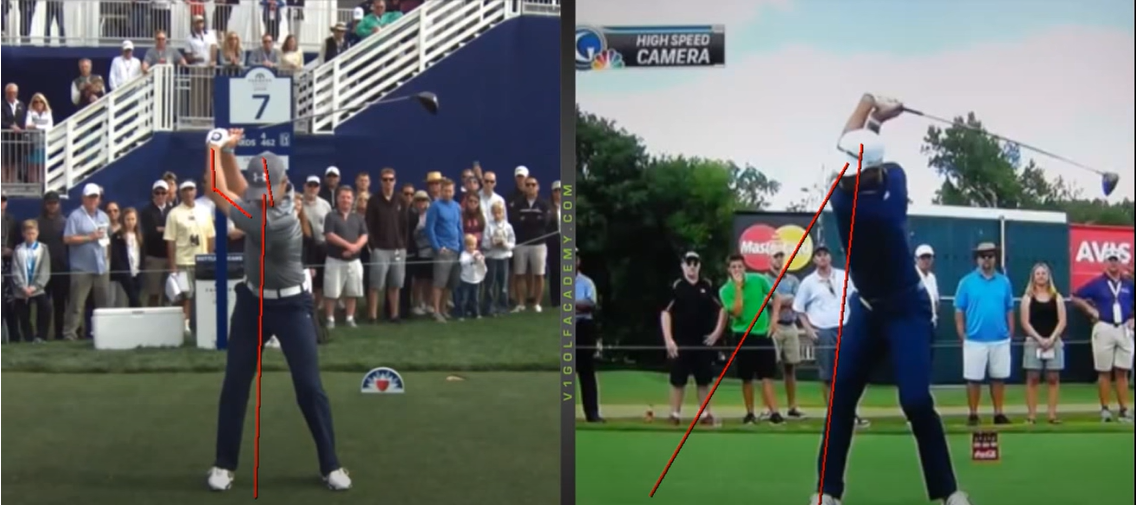
SURVEY RESULTS

Prediction: There are more Type II players on tour than Type I although there are more Type I people in the general population than Type II.
Based on the survey of 169 elite golfers, 52% were found to have Type II eye dominance, while 48% had Type I eye dominance. When considering only the female golfers in the sample, 68% had Type II eye dominance and 32% had Type I eye dominance. These findings suggest that there may be a relationship between eye dominance and golfing ability among elite players, particularly among female golfers.
To give context to our survey results on the eye dominance of elite golfers it is important to understand the eye dominance in the general population. To address this gap in the literature, my team and I conducted a survey of 600 individuals from the general population based on my findings from working as an optometrist with over 35 years of experience, to determine the prevalence of type I and type II eye dominance. Based on our preliminary findings, 65% of the participants exhibited type I eye dominance, while the remaining 35% exhibited type II eye dominance.
This survey provides a crucial foundation for future research on eye dominance in golfers and sheds light on the prevalence of eye dominance among both elite golfers and the general population. However, further research would be needed to confirm this relationship and explore any potential underlying mechanisms. (See further discussions below)
To get a sense of how golfers and coaches think about eye dominance, we reached out to several experts in the field. Here are a few quotes:
“Richard has been the bridge between optometry and golf and his work is providing a logical understanding of cause and effect which is resonating with elite players of the game.” - Geraint Griffiths, Chair of the Association of sport and schools and practitioners
"If an amateur were to look at the evolution of Golf Instruction, they should - without too much effort - be able to pin-point on a map the various breakthroughs that have shaped our current understanding of the Golf Swing. Unfortunately, such a map - dating from the origins of the game to present day - would still be lacking in the one thing necessary to tangibly change someone's game. A Key - Eye Dominance and the Science behind what we actually see, has the potential to become that Key" - John Jamieson, PGA Professional Cataraqui Golf and Country Club, Kingston, Ontario, Canada
“Jim Hartnett Type I often think of themselves as underachievers at golf when in reality it’s often the importance of their eye dominance that affects the mechanics of the golf swing.” - Jim Hartnett, US PGA Professional
“From a coaching perspective it’s very important to know a players eye dominance and range of motion that will allow them to see the ball throughout their swing.” – David Mortimer, PGA Professional Galway Golf Club
“I find it remarkable (understanding Richard’s research on eye dominance) that through my coaching towards elite players, their alignment (mainly shoulders) are open to the target for Type I’s. For elites, this then mainly sees the face angle to the right of the target for a right handed player to compensate for trunk being aligned to the left of it.
I have personally struggled with chipping and putting problems but understanding fixation defines the overwhelming sense of panic players face. I have worked with students recently on recollecting impact on short shots. I think this is directly related to fixation and the correct amount of time a player spends looking at the ball. Understanding eye dominance and the connection between optometry/golf may well answer a lot of unanswered questions.” – Gary Madden, PGA Professional Glenlo Golf Club

Conclusion

In conclusion, I would like to extend my sincerest gratitude to Jim Hartnett, John Jamieson and Geraint Griffiths for their invaluable collaboration and assistance on the topic of eye dominance of elite golfers. Their expertise, guidance, and input were critical in shaping the direction of the articles and ensuring that the research was presented in a clear and concise manner. John Jamieson and Jim Hartnett, as PGA professionals, provided invaluable insights into the golfing world and offered a wealth of knowledge and experience. Geraint Griffiths, as the Chair of the Association of Sport and Schools and Practitioners, were essential in helping me to understand the complexities of the topic and the implications of the research. I am deeply grateful for their contributions and the time and effort they dedicated to this project.
In my hometown of Galway, I have to thank the following people that have been a great source of information and support in developing these concepts in our research on the eye dominance of elite golfers:
o David Mortimer PGA Professional Galway Golf Club,
o Gary Madden, PGA Professional Glenlo Abbey Golf Club
o Tom Nolan, Plus handicap golfer for many years
o Joe Lyons, International golfer
Further discussions to be had:
1. The biomechanics of Type I and Type II elite players are important to measure in a golf lab to compare the size of their backswing and turn of their head through impact. Type I players tend to have a shorter backswing and more turn of their head through impact. Type II players, on the other hand, tend to have a longer backswing and less turn of their head through impact. By measuring the biomechanics of these players in a golf lab, we can better understand how these factors contribute to their success on the course and potentially develop training programs to help players improve their swings depending on their eye dominance.
2. Eye dominance is an important factor for golfers. In our survey of scratch or better golfers, we found that more elite players are cross dominant. Understanding a player's eye dominance can help coaches and players develop more effective training programs and strategies for playing the game.
3. There seems to be a greater number of Type II lady golfers at the elite level than male elite golfers. Women tend to have less upper body strength than men, which may make it more difficult for them to generate power with a shorter backswing and less turn through impact. Further research is needed to fully understand these differences and their impact on elite female golfers.
4. The physiological differences between Type I and Type II players should be understood from when a player takes up golf. By identifying a player's swing style early on, coaches and players can develop training programs and strategies that are tailored to their individual needs and strengths. This can help players to develop better swing mechanics, improve their accuracy and power, and ultimately become better golfers. Understanding these differences can also help coaches to identify talented young golfers and develop them into elite players.







